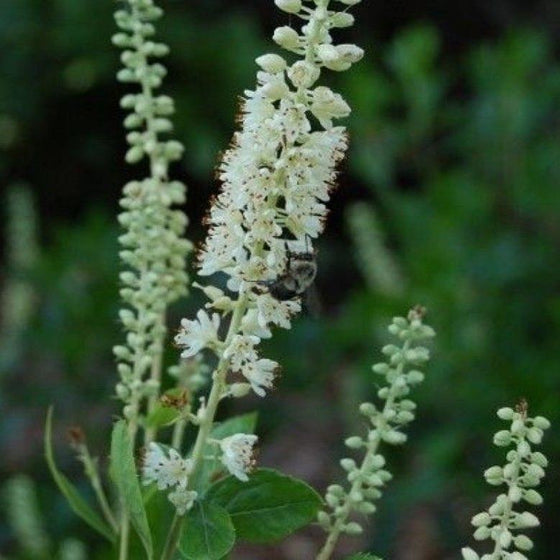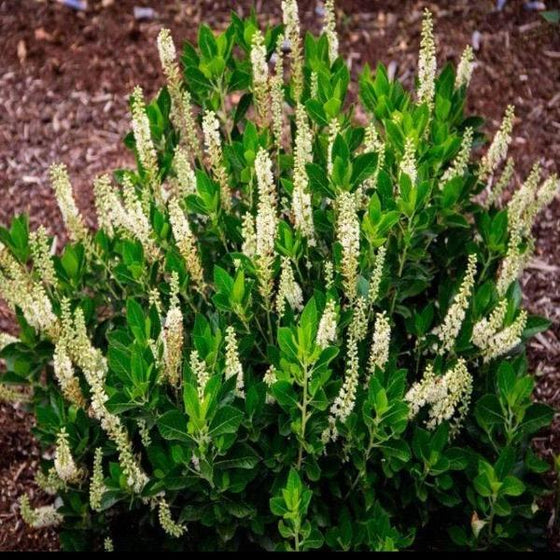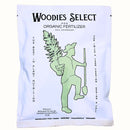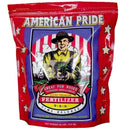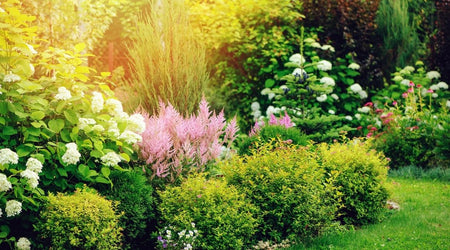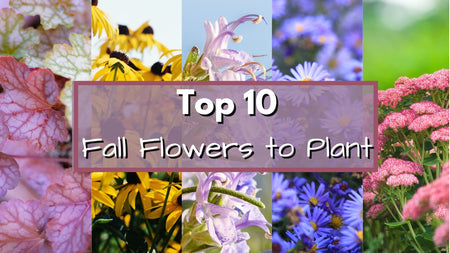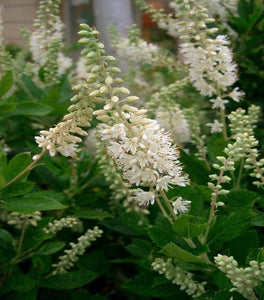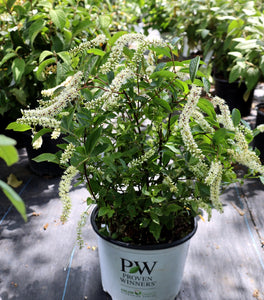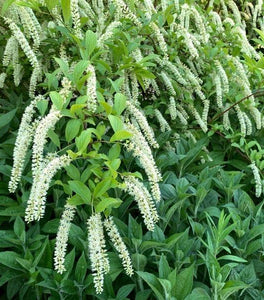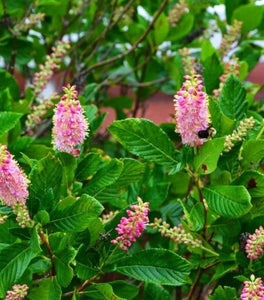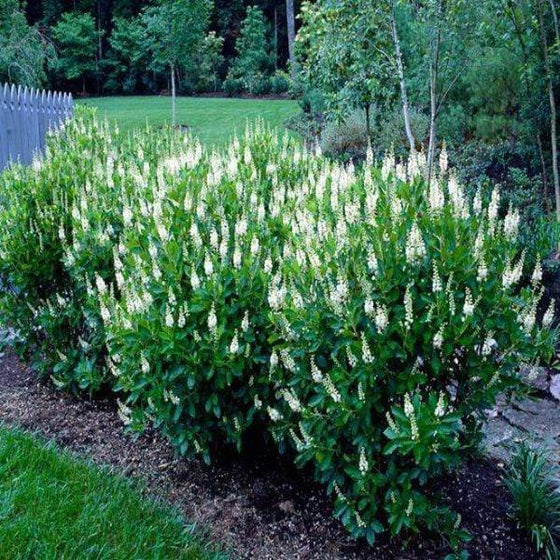
Images Depict Mature Plants
Clethra Sixteen Candles
Clethra alnifolia ‘Sixteen Candles’ is a compact, deciduous flowering shrub prized for its fragrant, upright white flower spikes and exceptional performance in shaded and moist garden areas. Also known as Summersweet, this native cultivar produces long, candle-like blooms in mid to late summer that attract bees, butterflies, and hummingbirds. The richly scented flowers are held above glossy, dark green foliage and provide a burst of color and fragrance when few other shrubs are blooming, making it a standout in the summer landscape.
Growing just 3 to 4 feet tall and wide, Sixteen Candles Clethra is ideal for small spaces, foundation plantings, woodland edges, and pollinator gardens. It thrives in full sun to partial shade and prefers moist, well-drained, acidic soils—making it an excellent choice for rain gardens, low spots, and areas with consistent moisture. This low-maintenance native shrub also offers fantastic fall interest, as its foliage turns a brilliant golden-yellow before dropping for the winter, adding a seasonal layer of beauty to your landscape design.
In addition to its ornamental value, Clethra Sixteen Candles supports biodiversity and provides reliable, long-season interest with minimal care. It’s deer resistant, tolerant of wet soils, and suitable for naturalized plantings or mixed borders with other moisture-loving natives like Itea, Fothergilla, and Blue Flag Iris. Whether you're creating a wildlife-friendly habitat or adding fragrance and structure to shaded beds, Sixteen Candles Clethra delivers dependable performance, native resilience, and multi-season charm in gardens of all sizes.
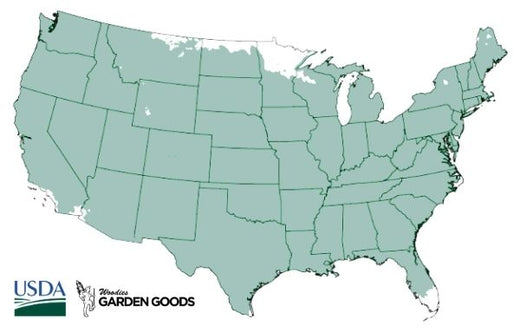
| Hardiness Zone: | 4-9 |
|---|---|
| Mature Height: | 2.5 to 3 Feet |
| Mature Width: | 3 to 4 Feet |
| Classification: | Deciduous shrub |
| Sunlight: | Full sun to part shade |
| Habit: | Dwarf, deciduous, densely branched, multi-stemmed clump forming |
| Flower Color: | Fragrant white flowers in mid to late summer |
| Foliage: | New growth emerges a dark green, changing to an golden yellow in the fall |
| Soil Condition: | Any well drained soil but will tolerate "wet feet" |
| Water Requirements: | Water well until established |
| Uses: | Extremely attractive when used as a focal point in the mixed border, mass planting, or a specimen planting. Provides unmatched winter interest especially when planted in front of a contrasting backdrop |
How to Care for Clethra Sixteen Candles
Be sure to read our planting instructions to ensure a healthy and happy Clethra Sixteen Candles for years to come!
How Should I Plant My Clethra Sixteen Candles Plants?
To plant your Clethra Sixteen Candles shrub, choose a location with full sun to partial shade and consistently moist, acidic, well-drained soil. This native cultivar thrives in rain gardens, woodland edges, and foundation plantings where moisture is plentiful and shade is filtered. Begin by digging a hole twice as wide and just as deep as the root ball. Gently loosen the roots before placing the plant in the hole, keeping the top of the root ball level with the surrounding soil. Backfill with a mixture of native soil and organic compost, firm the soil gently, and water thoroughly to eliminate air pockets and establish root contact. After planting, apply a 2- to 3-inch layer of mulch around the base of your Sixteen Candles Clethra to conserve soil moisture, regulate temperature, and suppress weed growth—keeping mulch a few inches away from the stem to prevent rot. This compact shrub is ideal for grouping in borders or mass planting along walkways where its fragrant blooms and pollinator activity can be fully enjoyed. With proper planting and soil preparation, Clethra Sixteen Candles will thrive and provide years of beautiful summer flowers, wildlife value, and vibrant fall color in your landscape.
How Should I Water My Clethra Sixteen Candles Plants?
Watering your Clethra Sixteen Candles properly is essential for establishing strong roots and promoting healthy growth and blooms. This moisture-loving native shrub prefers consistently damp soil, especially during the first growing season. Water deeply once or twice per week, depending on weather conditions, ensuring that the root zone stays evenly moist but not soggy. Using a soaker hose or drip irrigation system is ideal for maintaining steady moisture levels while avoiding water on the foliage, which can reduce the risk of fungal diseases. Once established, Sixteen Candles Clethra remains moderately drought tolerant but will perform best when watered during extended dry spells, particularly in the heat of summer when it is actively blooming. A 2- to 3-inch layer of mulch around the base helps retain moisture and regulate soil temperature. Regular watering encourages lush foliage, abundant fragrant blooms, and vibrant fall color. Whether planted in a rain garden, shaded border, or foundation bed, consistent moisture will ensure your Clethra Sixteen Candles thrives and continues to attract pollinators year after year.
How Should I Fertilize My Clethra Sixteen Candles Plants?
To fertilize your Clethra Sixteen Candles plants effectively, apply a balanced, slow-release fertilizer—such as a 10-10-10 formula—in early spring as new growth begins. This native shrub thrives in slightly acidic soils, so using a fertilizer formulated for acid-loving plants can enhance performance and help maintain optimal soil pH. Apply the fertilizer around the base of the plant, avoiding direct contact with the stem, and water it in thoroughly to help nutrients reach the root zone. Organic options like compost or aged manure can also enrich the soil naturally and support healthy growth. Avoid over-fertilizing, as excessive nutrients can lead to leggy growth with fewer blooms. In most garden settings, one spring application is sufficient, especially if the soil is rich in organic matter. If your Sixteen Candles Clethra is grown in poor or sandy soil, consider a second light feeding in mid-summer to encourage extended flowering. With proper fertilization, this compact, fragrant shrub will deliver strong growth, vibrant foliage, and a profusion of pollinator-friendly white blooms that make it a standout in rain gardens, woodland borders, and moisture-rich foundation plantings.

How and When Should I Prune My Clethra Sixteen Candles Plants?
Pruning your Clethra Sixteen Candles should be done in late winter or early spring, just before new growth begins. This compact shrub blooms on new wood, so cutting it back before the growing season encourages a fresh flush of foliage and a strong display of summer blooms. Begin by removing any dead, damaged, or crossing branches to improve air circulation and shape the plant. Light pruning can also help maintain its naturally upright, tidy form, especially in formal borders or foundation plantings. Avoid heavy pruning in the fall, as this can remove developing buds and reduce next season’s flower display. Instead, focus on annual spring maintenance to keep your Sixteen Candles Clethra healthy, compact, and productive. While this native shrub doesn’t require aggressive shaping, regular removal of old wood and occasional thinning will support better flowering and improve overall plant vigor. With proper pruning, your Clethra Sixteen Candles will remain a reliable source of fragrant blooms, rich green foliage, and vibrant fall color year after year in rain gardens, mixed borders, or pollinator plantings.

